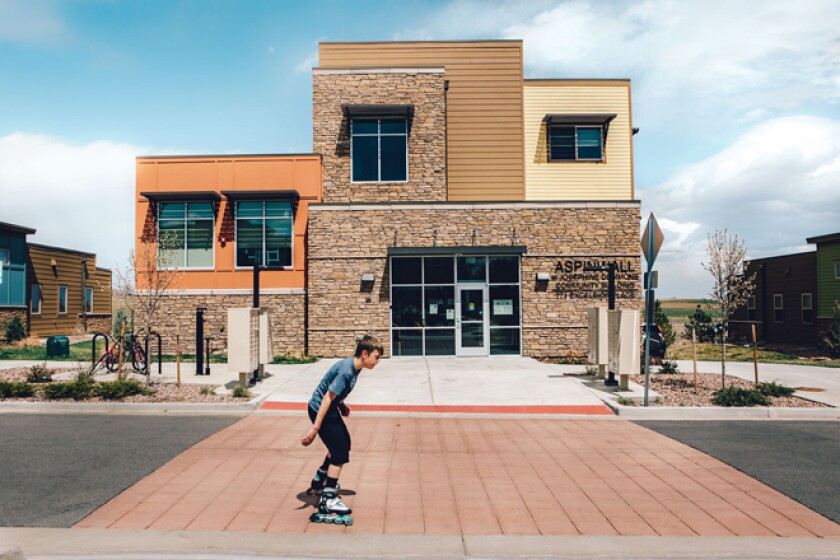“We were thinking, ‘How do we make a collective impact on homelessness?’” says Nick Macchione, director of the county’s health and human services agency. The problem, he says, was that homeless people didn’t just need housing. They also frequently needed to be connected with other health and human services programs in order to thrive. But trying to coordinate those programs was a challenge. “We were working with many well-meaning housing providers who didn’t understand how Medicaid works,” he says. “And vice-versa, there was stuff related to housing that I had to learn. And all of us just want to help the same people, who all happen to be our clients.”
The county had already launched a program that sought to coordinate housing, health and rehabilitation services specifically for chronically homeless people suffering from mental illness. Officials began toying with the idea of expanding that approach to combine all their efforts related to housing and the array of other programs that touch the lives of low-income residents.
The plan? A merger. As of July 1, San Diego officially merged those services into a new Health, Housing and Human Services Department. The underlying philosophy, says Macchione, who heads the new superagency, is simple: “No home, no health.”
San Diego is the largest jurisdiction to pull off this kind of merger in recent years, but it’s far from the only one. Governments in much of the country are looking at the idea. And as they consider it, they are bound to ponder the experiences of the real pioneer in this effort: Boulder County, Colo.
In 2009, Boulder became the first county in the nation to merge its housing and human services functions into one single agency. In doing so, Boulder put itself among the vanguard of places that were beginning to focus on the social determinants of health -- the idea that it’s fruitless to address community health without also tying in things like food security, transportation access, rehabilitation services and employment. “We know that poverty equals poor health outcomes,” says Frank Alexander, director of Boulder County’s Housing and Human Services department. “If you don’t connect housing with public health, you’re never going to benefit from the social determinants framework.”

“We have a lot of people dealing with job loss, income loss, housing instability. All of these economic factors begged for a new department that could address all of these issues.” — Frank Alexander, director of Boulder County’s Housing and Human Services
As more places around the country experiment with a “whole person” approach to housing and human services, Boulder provides a blueprint for what can work -- and a warning about what pitfalls to avoid. It’s never easy to merge programs, let alone entire departments. Balancing multiple priorities and funding streams can be problematic. But as the field of human services coalesces around a focus on the social determinants of health, more cities and counties will be exploring the same question: Just how linked are homes and health?
Boulder County, with the city of Boulder at its heart, is well known for its quirky vibe. Bikes can outnumber cars on downtown streets, and Tibetan handicraft boutiques seem as common as coffee houses. It’s a laid-back livability that’s made Boulder a prime draw for new residents in recent years. As a result, housing prices have shot up. Average rents in the county have risen 50 percent since 2011, and the median home value has jumped 32 percent since 2010. The annual income needed to rent a two-bedroom apartment in Boulder is $49,280, but the median income for renters sits at about $37,000.
In the early 2000s, Alexander became concerned about the devastating effect of housing costs. As the county housing authority director at the time, he could see the housing crisis of 2008 on the horizon. “The recession wasn’t here yet,” he says, “but you could practically smell it coming. There was stress in the air.”
Meanwhile, community needs assessments suggested something Boulder officials likely already knew: For people who needed the housing department’s services, the county’s other services systems were too complicated and challenging to navigate. The county, says Alexander, was “really experiencing this new phenomenon of suburbanization of poverty. We have a lot of people dealing with job loss, income loss, housing instability. All of these economic factors begged for a new department that could address all of these issues.”

Boulder County has taken steps to provide better services for low-income residents like Winnie Lawson, who recently moved from New Mexico to be near her children. She says she’s “so glad” to have the amenities.
Alexander began thinking of how the county might address its residents’ needs in a different way. He wanted to create a one-stop shop where people could get all the public benefits they need in one place, with housing as the foundation for a healthy life.
A few factors converged to make the department merger a reality. First, the county’s social services director was retiring, which meant that Alexander could leverage that leadership opening to start a conversation about reorganization. Second, as county leaders began to see the full weight of the recession, they were more willing to talk about an organizational transition, particularly one that could potentially cut costs while more efficiently delivering services to residents in need. In January 2009, Boulder County merged its housing authority and social services department into a single agency.
One of the biggest immediate benefits was a technological one: data integration. Every public benefits program -- including Section 8, Medicaid and the Supplemental Nutrition Assistance Program (SNAP) -- has its own unique set of qualifications. By merging departments, Boulder also merged that information into a single database. Now, about seven years after the merger, the department says it has about 80 to 90 percent of a client’s information housed in the unified database, and it’s working on data sharing and other partnerships with local community organizations that give them a more holistic picture of a family in need. “We’ve had to take the hood off each of these systems, and [now] we have a better picture of the client that is being served,” says Jason McRoy, director of business operations and support for Boulder County HHS. “We can see where they are and if there’s a gap or something being missed that would benefit them.”
This integration of data has been instrumental in building Kestrel, a 192-unit affordable housing development set to open next spring in the Boulder County town of Louisville. The team working on the project was able to see the services already available within the town, as well as the makeup of the community, in order to decide what sort of programs and services would best benefit residents of the new development.
For example, as soon as struggling families are settled in at Kestrel, they’ll have the option to enroll in the five-year Family Self-Sufficiency program that helps families meet specified goals. That goal can range from no longer needing SNAP benefits to becoming homeowners. Family self-sufficiency programs are hardly unique to Boulder -- it’s a federally funded program -- but the county offers residents resources that help them move toward their goals, such as financial literacy classes, homeownership training courses and career development workshops. And because of the merged department, the county can pinpoint which programs Kestrel residents want the most and offer that help literally at their doorstep.

Market-rate apartments in Boulder County overlook an affordable housing construction site.
But Boulder’s transition wasn’t seamless. Merging departments during the worst economic downturn in recent history meant cutbacks and additional headaches. Thanks to a lack of funding, the new agency had to close an office building, freeze hiring and cut positions. A total of 35 positions were ultimately cut, out of a department of about 500 employees. Morale was low, and Alexander, the director, continually had to reassure residents that the merger had been a good idea, one that would help deliver services better.
Then the department had a chance to prove its mettle. In 2010, Boulder County suffered a damaging wildfire, followed in 2013 by a flood that destroyed more than a billion dollars of property. For the HHS department, they were defining events. “We set up a disaster assistance center, where people could register for FEMA, get clothes, get food, find housing and get connected to mental health providers,” says Sarah Buss, the housing and emergency services coordinator for the department. “It would have been a very different situation if we had just been a housing authority or social services department.”
Combining efforts on housing and other services is an idea that’s beginning to take hold across the country. In the years since Boulder’s merger, a handful of other counties have taken steps to coordinate their housing and human services efforts. Pennsylvania’s Allegheny County, which includes Pittsburgh, and Olmsted County, Minn., which includes the city of Rochester, have both consulted with Boulder on how to create a stronger delivery system with housing and human services departments, although neither of those counties has formally merged those departments.
The city of Spokane, Wash., did merge its housing and social services departments in 2012. But it’s had a rockier ride than Boulder. Officials in Spokane say the merger has led to a 10 percent decrease in operating costs because of previously overlapping programs. But two different audits in the two years following the merger pointed to a mishandling of grant money. “There were growing pains on the administrative level, and we had some work we had to do because of it,” says Jonathan Mallahan, director of community and neighborhood services for Spokane. “But now, I think our department is strong. Spokane is a midsized city where homelessness is starting to go down -- other cities in Washington can’t say that -- and I think that’s because of our merger.”
The potential for mishandling funds is only one potential pitfall of mergers like this, says Tracy Wareing Evans, the executive director of the American Public Human Services Association. Another, she says, is deciding what to prioritize. Historically, governments set up standalone housing authorities precisely to ensure the issue of housing remained a high priority, with no conflicts of interest. In a merged department, those priorities aren’t as clear-cut, she says. “If you’re housing and human services, can one overshadow the other? Will your dollars get allocated equally?”
It’s too soon to call these types of full-scale mergers a nationwide trend, Wareing Evans says. One big reason for that, she says, is that federal funding for public benefits programs is still split among multiple different agencies. “The federal government is very siloed in how it gives money. So in order for this to be a widespread trend, I think there would have to be some structural change at the federal level.”
Nonetheless, she says, the conversation about human services increasingly includes the issue of housing -- and that’s a good thing. “I think it’s more about people looking at the social determinants of health, and really trying to get to the basics of how people can be their healthiest self,” she says. “And housing is such a key part of that. Can you be a productive student in school if you don’t have a home?”

Aspinwall, an affordable housing complex in Boulder County, offers family self-sufficiency programs to residents on-site.
In the seven years since the Boulder merger, the county has embraced a new mindset about the connectedness of social programs. “We’ve got child protective services workers who now feel comfortable sharing something with a housing case manager, who previously might have been viewed as the enemy because they were looking to kick someone out,” says Buss, the Boulder housing and emergency services coordinator. “That sort of evolution has occurred because of our shared mission.”
In San Diego, Macchione hopes for a similar shift in the way his county approaches these issues. “Change can be scary, but we have to march forward and try something new,” he says, adding that he considers Boulder’s achievement “an inspiration to us all.”
“When you move to a more collaborative [approach], you’re going to see more value there. You’re going to come up with solutions you would have never thought of before.”
And he knows that this kind of culture change takes time. He was working in San Diego in 1997 when the county first formed the Health and Human Services Department, itself a merger of six previously separate county programs. “It took about a decade to create a common culture there,” he says, “and there were plenty of lessons learned.”









